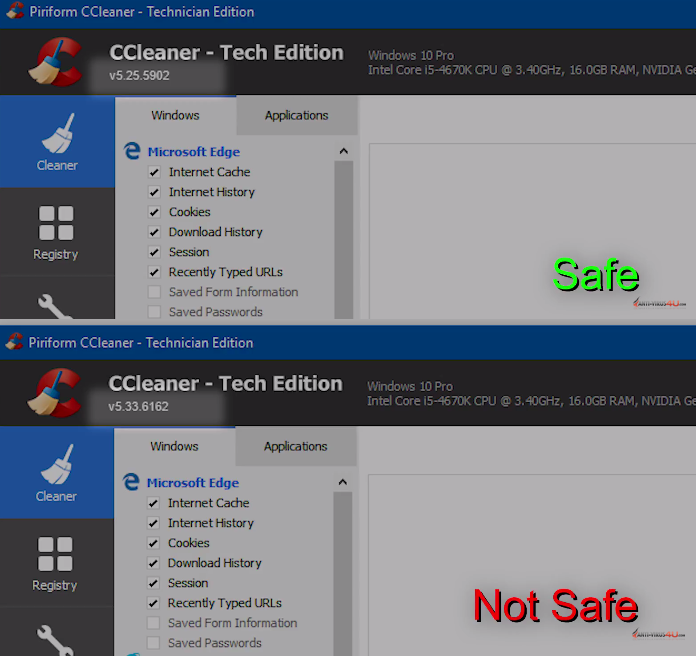
- #CCLEANER MALWARE HACK HOW TO#
- #CCLEANER MALWARE HACK UPDATE#
- #CCLEANER MALWARE HACK MANUAL#
- #CCLEANER MALWARE HACK FULL#
- #CCLEANER MALWARE HACK WINDOWS 10#
The second payload brought in Trojan.Nyeta, which was installed to modify the Windows Registry. The spyware gathered the data of all running processes. The first spread installed spyware called Floxif on the computers. The 5.3 version of CCleaner that got compromised produced two payloads of malware.
#CCLEANER MALWARE HACK FULL#
You should run a full scan of your antivirus software to catch any malware that could be present on your machine. Removing the CCleaner program may not clean your device if you’ve got malware.

Then select the app and choose Move to Trash. You may need to confirm that you wish to uninstall the program.įor Mac users, you can simply search for the CCleaner app or locate it in the Applications tab of your Finder window. Find the CCleaner program and select Uninstall. If you’re using a previous version of Windows, you can go to the Control Panel and click Programs.
#CCLEANER MALWARE HACK WINDOWS 10#
This step depends on your operating system, but with Microsoft Windows 10 and later, you go to your Start menu, choose Settings (the cogwheel), and click Apps. You’ll need to uninstall the CCleaner app first, but you’ll have the option to reinstall a later version if you choose. If you know you’ve been the recipient of CCleaner malware, you can remove it from your device.
#CCLEANER MALWARE HACK HOW TO#
When that’s the case, knowing how to remove malware will help you clean your device and get it ready to use again. Life happens, and there’s no shortage of malware ready to invade when given the opportunity. There may be some modified versions of files that you want to save while deleting the rest to free up space. That function will search your device for any duplicate files that you can then delete. You can also use the Duplicate Finder feature of CCleaner. A product like CCleaner will look through your temporary files and show you how much space might be wasted storing them.

They may stack up over time, blocking space on your device. If you do any web browsing, you may already know that your device captures and stores temporary files from websites. Either way, the feature offers insight into how your device is performing. Once you know what impacts performance, you can choose how to proceed and whether you want to keep the files or remove them. It scans your files to see which ones take the most space. Regarding performance, some of the most avid users of CCleaner love the Disk Analyzer function. Once that finishes, your device should offer optimized performance. Then, you can clean out those files from the internet cache, browsing history, and temporary files folder. The app allows you to see a list of files it deems as unnecessary.
#CCLEANER MALWARE HACK MANUAL#
You can also perform manual cleaning of junk files.

It looks for entries that could slow down your device. Many people like the ease of use CCleaner offers and that you can use it for free.ĬCleaner has a registry cleaner that goes through out-of-date or invalid files. The popularity of CCleaner comes from its many features. Years before the malware problem, CCleaner was the gold standard for computer users wanting to optimize device performance. You can think of CCleaner as a cleaning tool designed to scrub files for device optimization. The utility tool CCleaner was made by Piriform in 2004, which was later acquired by Avast in 2017. Unfortunately, the CCleaner malware issues came after many users found great potential in the service. With multiple malware infections discovered, you may wonder why anyone would use this product.
#CCLEANER MALWARE HACK UPDATE#
You may also see a message letting you know an update is available. If you don’t have the latest safe version, you’ll need to update your app. The version you have now will show in the upper left corner next to the CCleaner logo.ģ. The Windows 32-bit version of the 2017 releaseįinding out which CCleaner version you have is simple and can be done by following a few steps.Ģ.CCleaner or CCleaner Cloud - both released in August 2017.You may not have an infection, but it’s best to remove these versions to avoid any potential malware. If you have any of the versions in the following list, they’re the products infected with malware. To know if you’re running the secure version, you should check your CCleaner app. You can also run your antivirus software to check for viruses or malware.Īt the time of this article, the latest version of CCleaner that’s safe to use is. If you’ve noticed your device has become slow to respond, you may have an infection. How do I tell if I have CCleaner malware? In this article How do I tell if I have CCleaner malware?


 0 kommentar(er)
0 kommentar(er)
